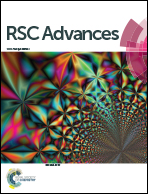1,4-Dihydroxyanthraquinone–copper(ii) supported on superparamagnetic Fe3O4@SiO2: an efficient catalyst for N-arylation of nitrogen heterocycles and alkylamines with aryl halides and click synthesis of 1-aryl-1,2,3-triazole derivatives†
Abstract
1,4-Dihydroxyanthraquinone–copper(II) supported on a superparamagnetic Fe3O4@SiO2 catalyst was employed for the N-arylation of nitrogen heterocycles and alkylamines with aryl halides to afford the corresponding coupled products in good to excellent yields without using external ligands or additives as promoters. Also, we have reported this recyclable catalytic system for efficient synthesis of 1-aryl-1,2,3-triazole derivatives in excellent yields. The desired triazoles were obtained from the reaction of the corresponding aryl boronic acid derivatives, alkyne, NaN3, and 0.5 mol% catalyst in water/acetonitrile as the solvent at room temperature without the additional use of an external reducing agent. These methods show notable advantages such as the heterogeneous nature of the catalyst, low catalyst loading, easy preparation, excellent yields, short reaction times and simplicity of operation. Also, the catalyst can be separated from the reaction mixture by applying a permanent magnet externally and can be reused in six consecutive reaction cycles without significant loss of activity.


 Please wait while we load your content...
Please wait while we load your content...